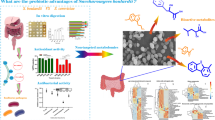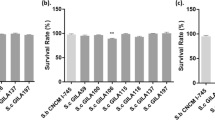Abstract
This study was designed to evaluate the effectiveness of recombinant polypeptide-p derived from Momordica charantia on diabetic rats. In this research, the optimized sequence of polypeptide-p gene fused to a secretion signal tag was cloned into the expression vector and transformed into probiotic Saccharomyces boulardii. The production of recombinant secretion protein was verified by western blotting, HPLC, and mass spectrometry. To assay recombinant yeast bioactivity in the gut, diabetic rats were orally fed wild-type and recombinant S. boulardii, in short SB and rSB, respectively, at two low and high doses as well as glibenclamide as a reference drug. In untreated diabetic and treated diabetic + SB rats (low and high doses), the blood glucose increased from 461, 481, and 455 (mg/dl), respectively, to higher than 600 mg/dl on the 21st day. Whereas glibenclamide and rSB treatments showed a significant reduction in the blood glucose level. The result of this study promised a safe plant-source supplement for diabetes through probiotic orchestration.






Similar content being viewed by others
Availability of data and materials
All relevant data are within the paper.
References
Albuquerque RC, Brandão AB, De Abreu IC, Ferreira FG, Santos LB, Moreira LN, Taddei CR, Aimbire F, Cunha TS (2019) Saccharomyces boulardii Tht 500101 changes gut microbiota and ameliorates hyperglycaemia, dyslipidaemia, and liver inflammation in streptozotocin-diabetic mice. Benef Microbes 10:901–912
Babendure JR, Babendure JL, Ding JH, Tsien RY (2006) Control of mammalian translation by mRNA structure near caps. RNA 12:851–861
Bagherpour G, Ghasemi H, Zand B, Zarei N, Roohvand F, Ardakani EM, Azizi M, Khalaj V (2018) Oral administration of recombinant Saccharomyces boulardii expressing ovalbumin-CPE fusion protein induces antibody response in mice. Front Microbiol 9:723
Blehaut H, Massot J, Elmer GW, Levy RH (1989) Disposition kinetics of Saccharomyces boulardii in man and rat. Biopharm Drug Dispos 10:353–364
Boddy AV, Elmer GW, McFarland LV, Levy RH (1991) Influence of antibiotics on the recovery and kinetics of Saccharomyces boulardii in rats. Pharm Res 8:796–800
Boudart G, Jamet E, Rossignol M, Lafitte C, Borderies G, Jauneau A, Pont-Lezica R (2005) Cell wall proteins in apoplastic fluids of Arabidopsis thaliana rosettes: identification by mass spectrometry and bioinformatics. Proteomics 5:212–221
Bouyssié D, Gonzalez de Peredo A, Mouton E, Albigot R, Roussel L, Ortega N, Monsarrat B (2007) Mascot file parsing and quantification (MFPaQ), a new software to parse, validate and quantify proteomics data generated by ICAT and SILAC mass spectrometric analyses: Application to the proteomics study of membrane proteins from primary human endothelial cells. Mol Cell Proteom 6:1621–1637
Brunk E, Chang RL, Xia J, Hefzi H, Yurkovich JT, Kim D, Buckmiller E, Wang HH, Cho BK, Yang C, Palsson BO (2018) Characterizing posttranslational modifications in prokaryotic metabolism using a multiscale workflow. Proc Natl Acad Sci 115:11096–11101
Drocourt D, Calmels T, Reynes JP, Baron M, Tiraby G (1990) Cassettes of the Streptoalloteichus hindustanus ble gene for the transformation of lower and higher eukaryotes to phleomycin resistance. Nucleic Acids Res 18:4009
Edwards-Ingram L, Gitsham P, Burton N, Warhurst G, Clarke I, Hoyle D, Oliver SG, Stateva L (2007) Genotypic and physiological characterization of Saccharomyces boulardii, the probiotic strain of Saccharomyces cerevisiae. Appl Environ Microbiol 73:2458–2467
Garau C, Cummings E, Phoenix DA, Singh J (2003) Beneficial effects and mechanism of action of Momordica charantia in the treatment of diabetes mellitus: a mini review. Int J Diabetes Metab 11:46–55
Graff S, Hussain S, Chaumeil JC, Charrueau C (2008) Increased intestinal delivery of viable Saccharomyces boulardii by encapsulation in microspheres. Pharm Res 25:1290–1296
He L, Yang H, Tang J, Liu Z, Chen Y, Lu B, He H, Tang S, Sun Y, Liu F, Ding X (2019) Intestinal probiotics E. coli Nissle 1917 as a targeted vehicle for delivery of p53 and Tum-5 to solid tumors for cancer therapy. J Biol Eng 13:1–3
Hoffmann CS, Winston F (1987) A ten-minute DNA preparation from yeast efficiently releases autonomous plasmids for transformation of Escherichia coli. Gene 57:267–272
Hudson LE, Fasken MB, McDermott CD, McBride SM, Kuiper EG (2014) Functional heterologous protein expression by genetically engineered probiotic yeast Saccharomyces boulardii. PLoS ONE 9:e112660
Isabella VM, Ha BN, Castillo MJ, Lubkowicz DJ, Rowe SE, Millet YA, Anderson CL, Li N, Fisher AB, West KA, Reeder PJ (2018) Development of a synthetic live bacterial therapeutic for the human metabolic disease phenylketonuria. Nat Biotechnol 36:857–864
Khanna P, Jain SC, Panagariya A, Dixit VP (1981) Hypoglycemic activity of polypeptide-P from a plant source. J Nat Prod 44:648–655
Klein SM, Elmer GW, McFarland LV, Surawicz CM, Levy RH (1993) Recovery and elimination of the biotherapeutic agent, Saccharomyces boulardii, in healthy human volunteers. Pharm Res 10:1615–1619
Kochetov A, Palyanov A, Titov I, Grigorovich D, Sarai A, Kolchanov N (2007) AUG_hairpin: prediction of a downstream secondary structure influencing the recognition of a translation start site. BMC Bioinform 8:318
Kozak M (1989) Circumstances and mechanisms of inhibition of translation by secondary structure in eucaryotic mRNAs. Mol Cell Biol 9:5134–5142
Kozak M (1990) Downstream secondary structure facilitates recognition of initiator codons by eukaryotic ribosomes. Proc Natl Acad Sci USA 87:8301–8305
Kudla G, Murray AW, Tollervey D, Plotkin JB (2009) Coding-sequence determinants of gene expression in Escherichia coli. Science 324:255–258
Kumar DS, Sharathnath KV, Yogeswaran P, Harani A, Sudhakar K, Sudha P, Banji D (2010) A medicinal potency of Momordica charantia. Int J Pharmaceutic Sci Rev Res 1:95–100
Li R, Wan X, Takala TM, Saris PE (2021) Heterologous expression of the leuconostoc bacteriocin Leucocin C in probiotic yeast Saccharomyces boulardii. Probiotics Antimicro 13(1):229–237
Liu JJ, Kong II, Zhang GC, Jayakody LN, Kim H, Xia PF, Kwak S, Sung BH, Sohn JH, Walukiewicz HE, Rao CV, Jin YS (2016) Metabolic engineering of probiotic Saccharomyces boulardii. Appl Environ Microbiol 82:2280–2287
Michael S, Keubler LM, Smoczek A, Meier M, Gunzer F, Pöhlmann C, Krause-Buchholz U, Hedrich H-J, Bleich A (2012) Quantitative phenotyping of inflammatory bowel disease in the IL-10-deficient mouse by use of noninvasive magnetic resonance imaging. Inflamm Bowel Dis 19:185–193
Praveschotinunt P, Duraj-Thatte AM, Gelfat I, Bahl F, Chou DB, Joshi NS (2019) Engineered E. coli Nissle 1917 for the delivery of matrix-tethered therapeutic domains to the gut. Nat Commun 10:1–4
Shibib BA, Khan LA, Rahman R (1993) Hypoglycemic activity of Coccinia indica and Momordica charantia in diabetic rats: depression of the hepatic gluconeogenic enzymes glucose 6 phosphatase and fructose 1,6 biphosphatase and elevation of both liver and red cell shunt enzyme glucose 6 phosphatase dehydrogenase. Biochem J 292:267–270
Subratty AH, Gurib-Fakim A, Mahomoodally F (2005) Bitter melon: an exotic vegetable with medicinal values. Nutr Food Sci 35:143–147
Sweere JM, Van Belleghem JD, Ishak H, Bach MS, Popescu M, Sunkari V, Kaber G, Manasherob R, Suh GA, Cao X, de Vries CR (2019) Bacteriophage trigger antiviral immunity and prevent clearance of bacterial infection. Science 363:eaat9691
Taylor L (2002) Herbal secrets of the rainforest, 2nd edition. Bitter Melon (Momordica charantia). Sage Press, Austin, pp 1–100
Terciolo C, Dapoigny M, Andre F (2019) Beneficial effects of Saccharomyces boulardii CNCM I-745 on clinical disorders associated with intestinal barrier disruption. Clin Exp Gastroenterol 12:67
Thomas MB, Vaidyanathan M, Radhakrishnan K, Raichur AM (2014) Enhanced viability of probiotic Saccharomyces boulardii encapsulated by layer-by-layer approach in pH responsive chitosan–dextran sulfate polyelectrolytes. J Food Eng 136:1–8
Tuller T, Zur H (2015) Multiple roles of the coding sequence 5 end in gene expression regulation. Nucleic Acids Res 43:13–28
Tuller T, Waldmanc YY, Kupiecd M, Ruppinc E (2010) Translation efficiency is determined by both codon bias and folding energy. Proc Natl Acad Sci USA 107:3645–3650
Wang BL, Zhang WJ, Zhao J, Wang FJ, Fan LQ, Wu YX, Hu ZB (2011) Gene cloning and expression of a novel hypoglycaemic peptide from Momordica charantia. J Sci Food Agri 91:2443–2448
Xiao W (2006) Yeast protocols. Human Press, New York, pp 15–21
Yamchi A, Ben C, Rossignol M, Zareie SR, Mirlohi A, Sayed-Tabatabaei BE, Pichereaux C, Sarrafi A, Rickauer M, Gentzbittel L (2018) Proteomics analysis of Medicago truncatula response to infection by the phytopathogenic bacterium Ralstonia solanacearum points to jasmonate and salicylate defence pathways. Cell Microbiol 20:e12796
Zylicz-Stachula A, Zolnierkiewicz O, Sliwinska K, Jezewska-Frackowiak J, Skowron PM (2014) Modified ‘one amino acid-one codon’ engineering of high GC content TaqII-coding gene from thermophilic Thermus aquaticus results in radical expression increase. Microb Cell Fact 13:7
Acknowledgements
We thank Arya Tina Gene (ATG)- Iran, and VProteomics-India companies for providing HPLC and mass spectrometry facilities in this research.
Funding
The authors received no specific funding for this work.
Author information
Authors and Affiliations
Contributions
AY initiated and supervised the project. He was involved in all parts of the experiments and paper writing. MR assisted in the upstream parts of the project (experiments) as her Ph.D. thesis. She helped to analyze the data and contribute to the writing of the paper. As coworkers, BJ, DA, and MS (M. Salmanian) assisted in the downstream parts of the project (experiments). They helped with the writing of the paper. MS (M. Shahbazi) advised the project and contributed to the final editing of the paper. All authors read and approved the final manuscript.
Corresponding author
Ethics declarations
Conflict of interest
The authors have no relevant affiliations or financial involvement with any organization or entity with a financial interest in or financial conflict with the subject matter or materials discussed in the manuscript.
Ethical consideration
All animal experiments were carried out according to the standard approved animal care guidelines and protocols, which were approved by the animal ethics committee of Golestan University of Medical Sciences, Gorgan, Iran, (IR.GOUMS.REC.1401.006).
Additional information
Communicated by Yusuf Akhter.
Publisher's Note
Springer Nature remains neutral with regard to jurisdictional claims in published maps and institutional affiliations.
Rights and permissions
Springer Nature or its licensor (e.g. a society or other partner) holds exclusive rights to this article under a publishing agreement with the author(s) or other rightsholder(s); author self-archiving of the accepted manuscript version of this article is solely governed by the terms of such publishing agreement and applicable law.
About this article
Cite this article
Yamchi, A., Rahimi, M., Javan, B. et al. Evaluation of the impact of polypeptide-p on diabetic rats upon its cloning, expression, and secretion in Saccharomyces boulardii. Arch Microbiol 206, 37 (2024). https://doi.org/10.1007/s00203-023-03773-9
Received:
Revised:
Accepted:
Published:
DOI: https://doi.org/10.1007/s00203-023-03773-9




